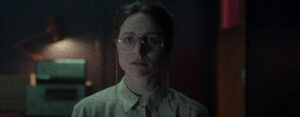
Prano Bailey-Bond has gained international attention for her first long feature film, Censor (2021), a dark and gritty horror about the strong relationship between cinema and the human mind. Grown on a diet of Twin Peaks, in the depth of a strange Welsh community, Bailey-Bond has always brought to life a kind of Burtonian imagination, fusing a dark vocabulary with an eerie allure for the uncanny, the most disturbing and secret aspects of human nature. In 2021, with Censor, Bailey-Bond was named a BAFTA Breakthrough, a “Director to Watch” by Variety, and selected as one of the Observer New Review “Faces of the Year”.
Focusing on the titular character, Enid (Niamh Algar), a young woman who makes a living tucked away in dingy screening rooms, watching depraved and gory films, classifying them, and cutting scenes of violence she thinks need to before the public views them, Censor is nothing as it seems. The arrival of “video nasty” star Frederick North’s new film sends Enid in a self-destructive and obsessive spiral, triggering in her some memories long lost and pushing her on a mission to find her sister who mysteriously disappeared many years before.
The movie has its roots in the 2015 short Nasty, which Bailey-Bond pitched to the BFI Short Film Fund as a pilot for her feature, reflecting the positive power of forbidden cinema. Precisely like in Censor, the protagonist of Nasty, a young boy named Doug (Albie Marber), longs for a lost loved one and believes he found a family connection through the portal of horror videos, particularly nasty ones. Nasty movies (low-budget exploitation films from the 80s heavily criticized for their violent content) on which the director landed after extensive research, are, indeed, at the center of both Nasty and Censor. However, Censor, unlike Nasty, has a distinctly British edge, setting its drama within an early-80s scandal specific to these shores.
For decades, Britain had been sheltered from the more outré elements of international cinema by the British Board of Film Censors (which changed its name to the British Board of Film Classification in 1984), which classified, cut, or outright rejected films submitted for public exhibition. In its 1983 manifesto, the Conservative Party made the specter of video nasties’ an election issue, promising to “respond to the increasing public concern over obscenity and offenses against public decency, which often have links with serious crimes”. In particular, the tabloid press led a campaign against so-called “video nasties”, a term not always clearly defined, but that included almost 70 titles (especially horror films) that had either been prosecuted by the Director of Public Prosecutions (DPP) under the Obscene Publications Act (OPA) or were awaiting prosecution. Central to the whole idea of the “video nasties’ scare” was the tendency for the press, politicians, and pundits to label something as “violence”, to judge it in simplistic moral terms, and thus look for causes of horrible events out of complex social and political reasons.
That tied into many of the themes of Censor: free will, the function of interpretation, the power to create a personal narrative, and the way that we read films according to what we want to see. Censor explores the blurred line between fiction and reality while trying to satirize and invert negative perceptions of horror. According to Bailey-Bond, indeed, horror isn’t vile or evil, a simply schlocky genre incapable of saying anything complex and intelligent, but rather the opposite; it is a darkly beautiful place with a strong healing and cathartic power. According to the director, horror represents an occasion to not only uncover and face collective and historical trauma but to process it and finally heal from it. This is contrary to the popular perception, according to which horror movies are harmful – can somehow do bad things to viewers, and therefore need to be cut or banned.
In both Nasty and Censor, Bailey-Bond subverts this belief by portraying two characters rescued by the cathartic power of horror. In the fiction of the horror world, they can have what they want while they can’t in real life. Playing with the Freudian theory of traumatic amnesia, Bailey-Bond uses the theme of censorship to connect the virtual world of the cinematic image with the repressed fears and anxieties of the human mind. The protagonist can’t exactly remember what happened the day her sister disappeared, and in a way, her job becomes a way of exploring that idea of censoring ourselves. So, the film is precisely not a recreation of any historical fact, but an exploration of the concept of trauma and psychological censorship. It is an ode to the power of cinema to trigger our minds and stir images, memories, and feelings in us, compensating for our inadequate reality. With a precise 80s aesthetic and disturbing cinematography, Censor stabs the audience with the gritty force of its narration and takes us on an uncanny journey through the turmoil of the human mind. Combining a very accurate and nostalgic reconstruction of the dark and tense atmosphere of the UK in the 80s with the theme of trauma and its aftermath, Bailey-Bond successfully contributes to the current debate of the power of art, artistic compensation, and representation in dealing with and healing from traumatic events. While playing with uncanny elements typical of the genre, the director stands out as highly modern and avant-garde in putting forth a new kind of horror where past and present combine, creating a new disturbing fascination for the audience.
Written for The Film Dispatch by Anna Chiari.

